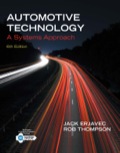
EBK AUTOMOTIVE TECHNOLOGY: A SYSTEMS AP
6th Edition
ISBN: 8220100474392
Author: ERJAVEC
Publisher: Cengage Learning US
expand_more
expand_more
format_list_bulleted
Concept explainers
Question
Chapter 13, Problem 8ASRQ
To determine
While tightening a TTY bolt: The technician with correct approach.
Expert Solution & Answer
Trending nowThis is a popular solution!

Students have asked these similar questions
25 mm
Brass core
E
=
105 GPa
0 = 20.9 x 10 °C
PROBLEM 2.49
The aluminum shell is fully bonded to the brass core and the
assembly is unstressed at a temperature of 15°C. Considering only
axial deformations, determine the stress in the aluminum when the
temperature reaches 195°C.
60 mm
Aluminum shell
E = 70 GPa
a = 23.6 × 10°C
This is an old practice exam. The answers are OAB = 19.10 ksi OBC = 2.228 ksi OCD = −2.865 ksi v = 0.2792delta Ltot = 0.01585 in (increase) but why
A random poly(styrene-butadiene) copoly-
mer has a number-average molecular weight of
350,000 g/mol and a degree of polymerization of
5000. Compute the fraction of styrene and buta-
diene repeat units in this copolymer.
H H
| |
-C-C-
방
H
Chapter 13 Solutions
EBK AUTOMOTIVE TECHNOLOGY: A SYSTEMS AP
Ch. 13 - True or False? Make sure you locate and adhere to...Ch. 13 - How does a torque-to-yield bolt differ from...Ch. 13 - How do seals differ from gaskets?Ch. 13 - Where are thread sealers most often used?Ch. 13 - What are the major differences between aerobic and...Ch. 13 - Which of the following statements is incorrect?...Ch. 13 - True or False? Valve lash is adjusted in many...Ch. 13 - Which of the following statements about the...Ch. 13 - True or False? The computer in most late-model...Ch. 13 - Graphite is. an anaerobic substance an RTV an...
Ch. 13 - Which of the following are considered soft, cut...Ch. 13 - What material is typically not used to form a rear...Ch. 13 - Which of the following statements about preparing...Ch. 13 - On hybrid vehicles, how can you identify the high...Ch. 13 - True or False? Some crankshaft and camshaft timing...Ch. 13 - Prob. 1ASRQCh. 13 - Technician A uses adhesives to hold gaskets in...Ch. 13 - Technician A uses soft gaskets on valve covers....Ch. 13 - Technician A inspects all sealing surfaces for...Ch. 13 - Technician A says that oil pan gaskets are often...Ch. 13 - Prob. 6ASRQCh. 13 - While discussing proper engine break-in:...Ch. 13 - Prob. 8ASRQCh. 13 - Prob. 9ASRQCh. 13 - While selecting the proper RTV for a particular...
Knowledge Booster
Learn more about
Need a deep-dive on the concept behind this application? Look no further. Learn more about this topic, chemical-engineering and related others by exploring similar questions and additional content below.Similar questions
- Design and assemble on the fluidsim (or a draft) the Hydraulic Drive Circuit, with the following characteristics: (a) Sequential operation, pressure, for the advance and return of the cylinders (according to the proper operation for the device) controlled by a directional 4x3 way, closed center; (b) Speed control for the cylinders, according to the load signal; (c) Pressure counterbalance for cylinder A, in order to compensate for the weight of the assembly.arrow_forwardThis is an old exam practice question. The answer is Pmax = 218.8 kN normal stress governs but why?arrow_forwardMoist air initially at T₁ = 140°C, p₁ = 4 bar, and p₁ = 50% is contained in a 2.0-m³ closed, rigid tank. The tank contents are cooled to T₂ 35°C. Step 1 Determine the temperature at which condensation begins, in °C.arrow_forward
- Air at T₁ = 24°C, p₁ = 1 bar, 50% relative humidity enters an insulated chamber operating at steady state with a mass flow rate of 3 kg/min and mixes with a saturated moist air stream entering at T2=7°C, p₂ = 1 bar. A single mixed stream exits at T3-17°C, p3=1 bar. Neglect kinetic and potential energy effectsarrow_forwardHand calculation of cooling loadarrow_forwardAn HEV has a 24kW battery. How many miles can it go on electricity alone at 40 mph on a flat straight road with no headwind? Assume the rolling resistance factor is 0.018 and the Coefficient of Drag (aerodynamic) is 0.29 the frontal area is 2.25m^2 and the vehicle weighs 1618 kg.arrow_forward
- As shown in the figure below, moist air at T₁ = 36°C, 1 bar, and 35% relative humidity enters a heat exchanger operating at steady state with a volumetric flow rate of 10 m³/min and is cooled at constant pressure to 22°C. Ignoring kinetic and potential energy effects, determine: (a) the dew point temperature at the inlet, in °C. (b) the mass flow rate of moist air at the exit, in kg/min. (c) the relative humidity at the exit. (d) the rate of heat transfer from the moist air stream, in kW. (AV)1, T1 P₁ = 1 bar 11 = 35% 120 T₂=22°C P2 = 1 bararrow_forwardThe inside temperature of a wall in a dwelling is 19°C. If the air in the room is at 21°C, what is the maximum relative humidity, in percent, the air can have before condensation occurs on the wall?arrow_forwardThe inside temperature of a wall in a dwelling is 19°C. If the air in the room is at 21°C, what is the maximum relative humidity, in percent, the air can have before condensation occurs on the wall?arrow_forward
- ###arrow_forwardFind the closed loop transfer function and then plot the step response for diFerentvalues of K in MATLAB. Show step response plot for different values of K. Auto Controls Show solution for transform function and provide matlab code (use k(i) for for loop NO COPIED SOLUTIONSarrow_forwardThis is an old practice exam. The answer is Ta-a = 4.615 MPa max = 14.20 MPa Su = 31.24 MPa Sus = 10.15 MPa but why?arrow_forward
arrow_back_ios
SEE MORE QUESTIONS
arrow_forward_ios
Recommended textbooks for you
 Automotive Technology: A Systems Approach (MindTa...Mechanical EngineeringISBN:9781133612315Author:Jack Erjavec, Rob ThompsonPublisher:Cengage Learning
Automotive Technology: A Systems Approach (MindTa...Mechanical EngineeringISBN:9781133612315Author:Jack Erjavec, Rob ThompsonPublisher:Cengage Learning Automotive TechnologyMechanical EngineeringISBN:9781337794213Author:ERJAVEC, Jack.Publisher:Cengage,
Automotive TechnologyMechanical EngineeringISBN:9781337794213Author:ERJAVEC, Jack.Publisher:Cengage,

Automotive Technology: A Systems Approach (MindTa...
Mechanical Engineering
ISBN:9781133612315
Author:Jack Erjavec, Rob Thompson
Publisher:Cengage Learning

Automotive Technology
Mechanical Engineering
ISBN:9781337794213
Author:ERJAVEC, Jack.
Publisher:Cengage,